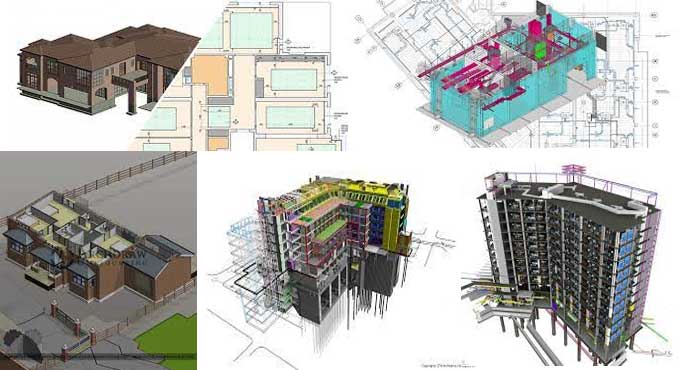Types of drawings used in building design using BIM
Tweet
In order to successfully complete a construction project, a construction plan must be created before the project can begin. An overview of the structure is given in this document. In order to achieve this purpose, a wide range of types of construction drawings are now being used as a means of communication.
There are many technical details that need to be presented in a legible manner in these drawings in addition to fulfilling the requirements for project clearance.
A building code serves as a benchmark for the construction process and ensures that the building codes are followed throughout the entire process.
Types of Drawings
Examples of Architectural Drawings
A few examples of architectural building drawings are mentioned below:
Site Plan Drawing: A Site Plan is an aerial representation of the construction site that depicts the main building as well as other structures.
Construction building drawings for construction upgrades and establishing the scope of construction operations are merely a few of the numerous uses of the Site plan design.
Floor Plan Drawing: This is a more thorough layout of the room. Floor plans in 2D and 3D are developed for use in the building of a house, a store, or a business enterprise. Among the uses are understanding, dimensions and various forms of installments.
Working Plan drawings: Section drawings, as the name says, depict the structure in a sliced shape. This sort of construction drawing aids in identifying the main structures in relation to the other structures of the building.
Elevation drawings: Elevation drawing aid architects in establishing the orientation of a structure. Elevation drawings for architecture make it easier to understand the direction of the sun and wind in relation to the building.
Final output drawings: As the elevation and finishing drawings both depict the tiniest aspects of a project, those two architectural drawings have a close connection.
Floor patterns, false ceiling type, and form, paint colors, plaster, textures, and other features can all be incorporated into many sorts of finishing designs.
Examples of Structural Drawings
A structural drawing is a design or collection of plans and details that depict the construction of a building or other structure.
Typically, licensed professional engineers create structural drawings based on the information supplied by the entire set of architectural drawings and design sets. Here are some examples of structural drawings:
Column layout drawings: The design and pattern of the column throughout the building are strengthened by the column layout.
This design splits the structure into levels and defines the precise size and spacing of each column. Column layout drawings help contractors grasp the general arrangement of the structure.
Plinth beam drawings: Plinth beam layout drawings are yet another sort of beam construction that enhances the support system of a building. Plinth detail drawings show how the plinth beams are placed, extended, and sectioned.
Roof beam drawings: A roof beam is used to reinforce a building's overall structure. A roof beam is a triangular structure that supports the roof and is generally constructed on the top of the building.
Structure?s Concept Drawings: A building project's concept drawings are more likely to be the very first draught. They aren't very distinct or detailed. The concept drawings are crude sketches of the structure and its surroundings.
Examples of Electrical and Plumbing drawings
A few examples of Electrical and Plumbing drawings are mentioned below:
Electrical layout drawings: A drawing of an electrical system describes in great detail all of the electrical components, such as connections, fixtures, outlets, lights, fans, switches, and other components.
As this drawing depicts the wiring layout on the floor, it appears as though it represents the electricians' pillars of support in understanding the wiring layout.
To get online demonstration, watch the following video tutorial.
Video Source: Autodesk Building Solutions
Plumbing layout drawings: As with electrical construction drawings, plumbing construction plans show the positions and marks of plumbing components in relation to one another. Everything is associated with plumbing, including water pipes, drainage systems, and sanitary pipes.
Drainage layout drawings: An illustration of a drainage diagram shows the flow of water into and out of a building structure. The maintenance of good drainage is one of the most important things you can do to ensure the health of future users of the construction project.
Examples of ventilation and HAVC Drawings
A few examples of HAVC drawings are mentioned below:
HVAC Drawings: HVAC drawings, often known as mechanical drawings, detail the ventilation and heating systems. They also discuss the air conditioning arrangement and patterns that will be implemented into the construction.
Safety Drawings: Prior to construction, firefighting strategies are developed. They plan the placement of water outlets, fire hoses, points, and other stuff. They also include the fire prevention strategy and the safety systems that will be implemented.
Conclusion
Construction drawings depict the progression of a structure from the conception of architectural structural features to completion and even after construction.
Some designs must be established prior to construction, while others must be produced during construction. There are various advantages to having these architectural design drawings for construction in your hands.

Gallery
Feel free to contact us for BIM requirements. One of our representative will respond you within 24 Hours. Send us your projects requirement today and grow your project.
Explore More !







